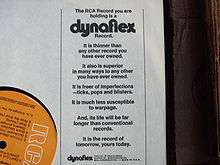Dynaflex (RCA)

Dynaflex was a trademark for a thin, lightweight vinyl LP record introduced by RCA Records in late 1969. Rather than using the stiff plastic material used by conventional vinyl pressings, Dynaflex records used a "flexible" formulation that allowed RCA to use less material, saving money and also making the record appear to lie flatter on turntables. At the time, many industry record pressing plants were using recycled or "reground" vinyl, taking old records, removing their paper labels, then melting them down and reusing the plastic components to make new records. Such "reground" vinyl records typically sounded much noisier than a record made from "virgin" vinyl; collectors noted that "reground" records sometimes had small remnants of paper labels embedded in the outer edge of the LP.
RCA's Dynaflex records varied somewhat in thickness, but some were so thin and flexible, they literally "flopped" back and forth when held in the hand. This flexibility also gave them theoretically more resiliency in shipping, resulting in fewer returns from retailers due to breakage and cracks. But critics charged that Dynaflex was little more than a smokescreen to allow RCA to save money by using less vinyl material than in a traditional, thicker pressing. It is noteworthy that RCA apparently never fully implemented the use of Dynaflex, as regular thick vinyl records continued to be manufactured. Some titles issued by RCA were available in both Dynaflex and heavier vinyl pressings.
Opinions from record collectors and audiophiles are divided as to Dynaflex's sound quality. Some felt that the sound quality actually improved, due to better processes for removing impurities in the vinyl compounds; others felt that Dynaflex pressings were both noisier and lacked bass frequencies compared to conventional records, and also had more "rumble" (low frequency noise) than conventional thick pressings. While RCA claimed that Dynaflex records were less susceptible to warpage and would last longer than conventional vinyl records, some consumers (particularly classical listeners) derided the new product, calling it 'Dynawarp' because of evidence that Dynaflex records were prone to warp on dealers' shelves, just from the pressure of the shrinkwrap on the album jacket.
RCA Records quietly discontinued Dynaflex sometime in the late 1970s.